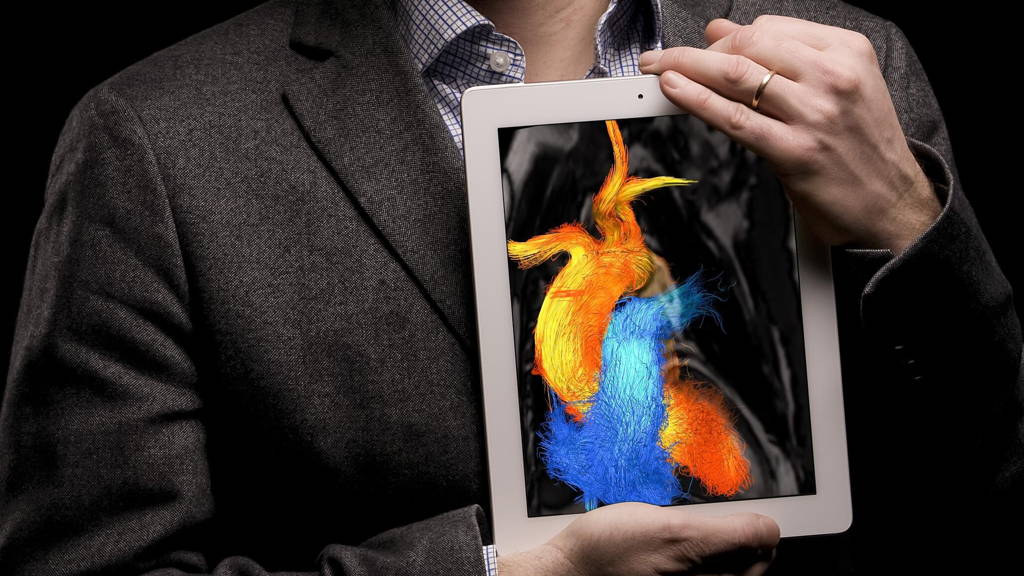It is the most common congenital heart defect: bicuspid aortic valve (BAV), a genetic condition in which patients are born with two flaps in their aortic heart valve instead of the usual three. So far, there isn’t a personalized approach for preventing the complications resulting from this defect. That’s something the Cumming School of Medicine’s Dr. Paul Fedak*, and Alex Barker, PhD, of Chicago’s Northwestern University Feinberg School of Medicine, hope to change with a five-year clinical research study.
BAV affects more than seven million people in North America, and 50 percent of them will require a life-saving intervention such as open-heart surgery. Popular TV and movie star John Ritter died at the age of 54 due to an aortic dissection. Just like most patients, Ritter didn’t know he had a flaw in his heart. People usually find out incidentally through tests for other medical conditions, or when there are aortic complications such as aneurysms or rupture.
BAV affects more than seven million people in North America, and 50 percent of them will require a life-saving intervention such as open-heart surgery. Popular TV and movie star John Ritter died at the age of 54 due to an aortic dissection. Just like most patients, Ritter didn’t know he had a flaw in his heart. People usually find out incidentally through tests for other medical conditions, or when there are aortic complications such as aneurysms or rupture.
Using 4D-Flow MRI for personalised treatment
Supported by a $3.3 million National Institutes of Health (NIH) RO1 grant, Fedak and Barker will use 4D-Flow MRI, a cutting-edge imaging technique that allows visualization of three-dimensional blood flow in real time, and tissue analysis to inform personalized treatment for BAV patients. The results of the study may cut down on the number of unnecessary open-heart surgeries while also identifying and targeting those who are at highest risk and need it most.
Not all BAV patients are the same, yet they are currently treated the same when it comes to timing and extent of surgery, Fedak points out. The cardiac surgeon is also professor in the departments of Cardiac Sciences and Surgery and member of the Libin Cardiovascular Institute of Alberta, Canada. “Through this study we can give clinicians and surgeons the tools they need to create precise, individualized treatment plans for patients.”
Not all BAV patients are the same, yet they are currently treated the same when it comes to timing and extent of surgery, Fedak points out. The cardiac surgeon is also professor in the departments of Cardiac Sciences and Surgery and member of the Libin Cardiovascular Institute of Alberta, Canada. “Through this study we can give clinicians and surgeons the tools they need to create precise, individualized treatment plans for patients.”
Better understanding of unique conditions
“Each patient’s condition is unique. We are developing state of the art MRI techniques to help with the assessment of their condition to develop the best plan of treatment,” Barker adds. According to the bioengineer and assistant professor in the Department of Radiology at the Feinberg School of Medicine, the use of this novel imaging technology can “provide a better understanding of the underlying cause of aortic aneurysms in addition to identifying the patients who are most at risk of complications.”
Phil Mittertreiner is a BAV patient who had surgery on his aorta done by Fedak to prevent it from rupturing. He was on a mountain bike ride this weekend and by coincidence all three male riders had BAV. “We were all very fortunate to have been diagnosed with BAV early in our lives. Mine required surgery, my two friends are fine for now. Because of the excellent care we received we are all able to ride hard, with confidence, worry free,” said Mittertreinder. “Unfortunately there are many others out there with BAV who are either completely unaware of the risks or who are living with significant life restrictions. This research should help remedy that.”
The NIH grant will allow for advanced tissue analysis for a large group of patients (450) over the next five years, the largest series in the world. Recruitment is already underway.
Phil Mittertreiner is a BAV patient who had surgery on his aorta done by Fedak to prevent it from rupturing. He was on a mountain bike ride this weekend and by coincidence all three male riders had BAV. “We were all very fortunate to have been diagnosed with BAV early in our lives. Mine required surgery, my two friends are fine for now. Because of the excellent care we received we are all able to ride hard, with confidence, worry free,” said Mittertreinder. “Unfortunately there are many others out there with BAV who are either completely unaware of the risks or who are living with significant life restrictions. This research should help remedy that.”
The NIH grant will allow for advanced tissue analysis for a large group of patients (450) over the next five years, the largest series in the world. Recruitment is already underway.






